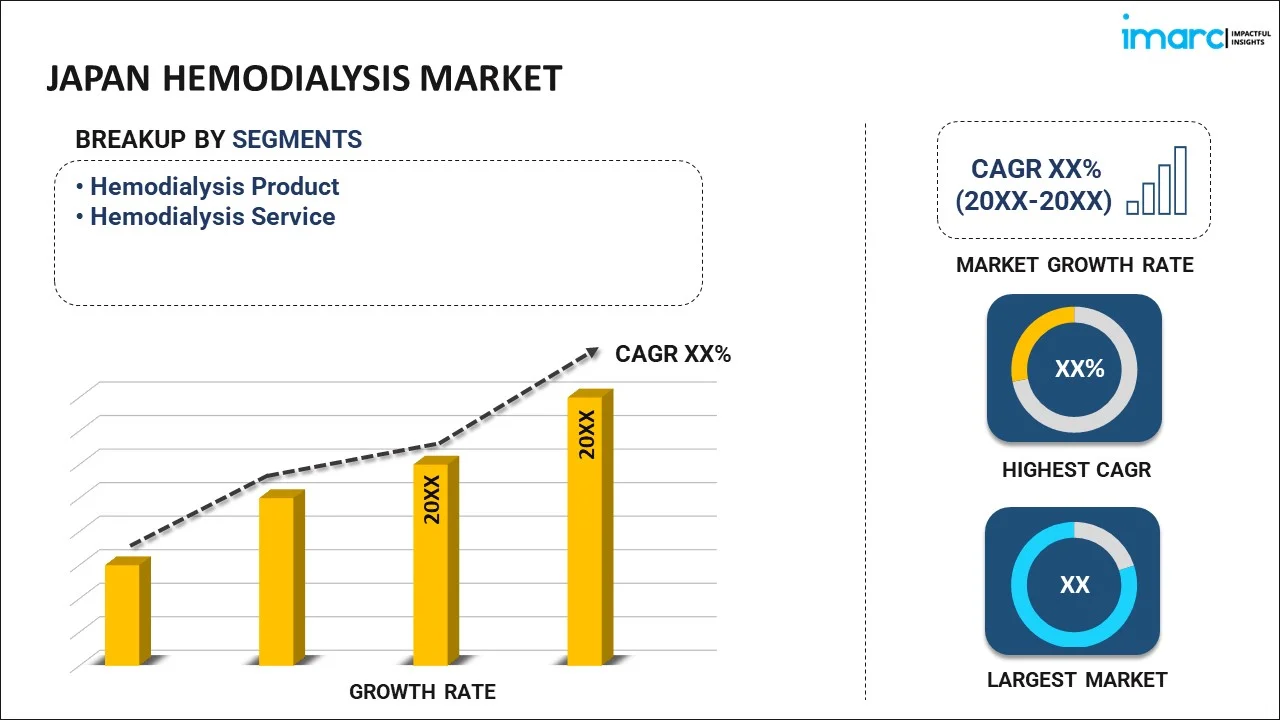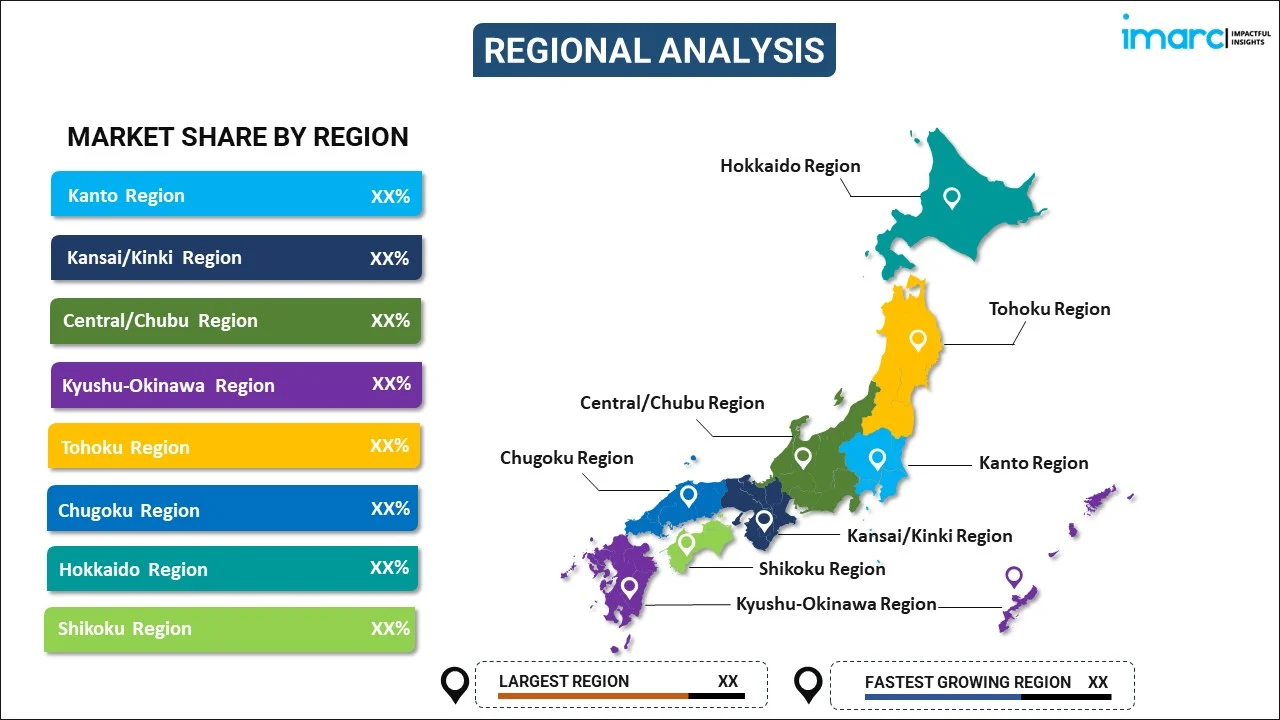
Japan Hemodialysis Market Report by Segment (Hemodialysis Product, Hemodialysis Service), Modality (Conventional Hemodialysis, Short Daily Hemodialysis, Nocturnal Hemodialysis), End User (Hospitals, Independent Dialysis Centres, and Others), and Region 2025-2033
Market Overview:
The Japan hemodialysis market size reached USD 4.2 Billion in 2024. Looking forward, IMARC Group expects the market to reach USD 7.3 Billion by 2033, exhibiting a growth rate (CAGR) of 5.8% during 2025-2033. The rapidly aging population across the country, ongoing technological advancements in dialysis, favorable government policies, and the availability of comprehensive healthcare coverage owing to high treatment costs represent some of the key factors driving the market.
|
Report Attribute
|
Key Statistics
|
|---|---|
|
Base Year
|
2024
|
|
Forecast Years
|
2025-2033
|
|
Historical Years
|
2019-2024
|
|
Market Size in 2024
|
USD 4.2 Billion |
|
Market Forecast in 2033
|
USD 7.3 Billion |
| Market Growth Rate 2025-2033 | 5.8% |
Hemodialysis is a medical procedure used to treat kidney failure. This treatment performs the functions of healthy kidneys, mainly removing waste products and excess fluid from the blood. It serves as a lifesaving intervention for patients with end-stage renal disease (ESRD) or chronic kidney disease at its most advanced stage. However, it does not cure kidney disease and is often accompanied by lifestyle changes and medications to manage the condition effectively. During hemodialysis, a machine and a special filter called a dialyzer, or artificial kidney, are used. The patient’s blood is circulated through the dialyzer, where it undergoes filtration. The process involves the diffusion of solutes across a semipermeable membrane, balancing electrolytes, and removing toxins like urea, potassium, and creatinine from the blood. Simultaneously, excess fluid is extracted, helping to control blood pressure. Hemodialysis treatments typically last for about four hours and are required three times a week. The procedure is conducted either in hospitals, dialysis centers, or, in some cases, at the patient’s home. Before starting hemodialysis, a minor surgical procedure is required to create vascular access in the form of an arteriovenous (AV) fistula, AV graft, or a central venous catheter, enabling efficient blood flow during the treatment. As a result, hemodialysis is crucial for maintaining the quality of life in patients with severe kidney dysfunction.
Japan Hemodialysis Market Trends:
The Japan hemodialysis market is experiencing robust growth, propelled by a combination of demographic, technological, and healthcare factors. One of the primary drivers is the rapidly aging population in Japan. The country has one of the highest proportions of elderly citizens globally, and age is a key risk factor for chronic kidney disease (CKD) and end-stage renal disease (ESRD). As the population ages, there is a rise in the prevalence of these conditions, leading to a greater demand for hemodialysis treatments. Moreover, advancements in hemodialysis technology are positively influencing market growth. For instance, innovations in dialysis machines and consumables, like high-efficiency and high-flux membranes, are improving the quality and effectiveness of hemodialysis. This technological evolution is increasing patient acceptance and comfort, further driving market growth. Additionally, the Japanese healthcare system offers comprehensive coverage to ensure that a larger segment of the population has access to necessary medical treatments, including hemodialysis. In line with this, several government policies and initiatives aimed at managing the growing burden of CKD and ESRD are supporting market growth. These include efforts to improve early detection and treatment of kidney diseases, which subsequently lead to a heightened demand for hemodialysis services, thereby fueling market growth. Furthermore, Japan’s strong focus on research and development (R&D) in the medical field encourages innovation in hemodialysis. Along with this, various leading Japanese companies are at the forefront of developing new and advanced dialysis products, thus contributing to market growth.
Japan Hemodialysis Market Segmentation:
IMARC Group provides an analysis of the key trends in each segment of the market, along with forecasts at the country level for 2025-2033. Our report has categorized the market based on segment, modality, and end user.
Segment Insights:

- Hemodialysis Product
- Machines
- Dialyzers
- Others
- Hemodialysis Service
- In-centre Services
- Home Services
The report has provided a detailed breakup and analysis of the market based on the segment. This includes hemodialysis product (machines, dialyzers, and others) and hemodialysis service (in-center services and home services).
Modality Insights:
- Conventional Hemodialysis
- Short Daily Hemodialysis
- Nocturnal Hemodialysis
A detailed breakup and analysis of the market based on the modality have also been provided in the report. This includes conventional hemodialysis, short daily hemodialysis, and nocturnal hemodialysis.
End User Insights:
- Hospitals
- Independent Dialysis Centers
- Others
The report has provided a detailed breakup and analysis of the market based on the end user. This includes hospitals, independent dialysis centers, and others.
Regional Insights:

- Kanto Region
- Kansai/Kinki Region
- Central/ Chubu Region
- Kyushu-Okinawa Region
- Tohoku Region
- Chugoku Region
- Hokkaido Region
- Shikoku Region
The report has also provided a comprehensive analysis of all the major regional markets, which include Kanto Region, Kansai/Kinki Region, Central/ Chubu Region, Kyushu-Okinawa Region, Tohoku Region, Chugoku Region, Hokkaido Region, and Shikoku Region.
Competitive Landscape:
The market research report has also provided a comprehensive analysis of the competitive landscape. Competitive analysis such as market structure, key player positioning, top winning strategies, competitive dashboard, and company evaluation quadrant has been covered in the report. Also, detailed profiles of all major companies have been provided.
Japan Hemodialysis Market Report Coverage:
| Report Features | Details |
|---|---|
| Base Year of the Analysis | 2024 |
| Historical Period | 2019-2024 |
| Forecast Period | 2025-2033 |
| Units | Billion USD |
| Scope of the Report | Exploration of Historical Trends and Market Outlook, Industry Catalysts and Challenges, Segment-Wise Historical and Future Market Assessment:
|
| Segments Covered |
|
| Modalities Covered | Conventional Hemodialysis, Short Daily Hemodialysis, Nocturnal Hemodialysis |
| End Users Covered | Hospitals, Independent Dialysis Centres, Others |
| Regions Covered | Kanto Region, Kansai/Kinki Region, Central/ Chubu Region, Kyushu-Okinawa Region, Tohoku Region, Chugoku Region, Hokkaido Region, Shikoku Region |
| Customization Scope | 10% Free Customization |
| Post-Sale Analyst Support | 10-12 Weeks |
| Delivery Format | PDF and Excel through Email (We can also provide the editable version of the report in PPT/Word format on special request) |
Key Questions Answered in This Report:
- How has the Japan hemodialysis market performed so far and how will it perform in the coming years?
- What has been the impact of COVID-19 on the Japan hemodialysis market?
- What is the breakup of the Japan hemodialysis market on the basis of segment?
- What is the breakup of the Japan hemodialysis market on the basis of modality?
- What is the breakup of the Japan hemodialysis market on the basis of end user?
- What are the various stages in the value chain of the Japan hemodialysis market?
- What are the key driving factors and challenges in the Japan hemodialysis?
- What is the structure of the Japan hemodialysis market and who are the key players?
- What is the degree of competition in the Japan hemodialysis market?
Key Benefits for Stakeholders:
- IMARC’s industry report offers a comprehensive quantitative analysis of various market segments, historical and current market trends, market forecasts, and dynamics of the Japan hemodialysis market from 2019-2033.
- The research report provides the latest information on the market drivers, challenges, and opportunities in the Japan hemodialysis market.
- Porter's five forces analysis assist stakeholders in assessing the impact of new entrants, competitive rivalry, supplier power, buyer power, and the threat of substitution. It helps stakeholders to analyze the level of competition within the Japan hemodialysis industry and its attractiveness.
- A competitive landscape allows stakeholders to understand their competitive environment and provides an insight into the current positions of key players in the market.
Need more help?
- Speak to our experienced analysts for insights on the current market scenarios.
- Include additional segments and countries to customize the report as per your requirement.
- Gain an unparalleled competitive advantage in your domain by understanding how to utilize the report and positively impacting your operations and revenue.
- For further assistance, please connect with our analysts.

 Inquire Before Buying
Inquire Before Buying
 Speak to an Analyst
Speak to an Analyst
 Request Brochure
Request Brochure
 Request Customization
Request Customization



.webp)




.webp)












